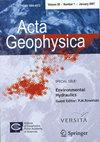Interseismic strain accumulation across the Tuolaishan–Lenglongling segment of the Qilian–Haiyuan fault zone prior to the 2022 Mw 6.7 Menyuan earthquake from Sentinel-1 InSAR time series
Abstract
The Tuolaishan–Lenglongling fault (TLSF–LLLF) is located in the middle-western segment of the Qilian–Haiyuan fault zone. The 2022 Menyuan Mw 6.7 earthquake that occurred in the TLSF–LLLF highlights the urgent need for understanding the mechanical property and seismicity over this fault segment. In this study, Persistent Scatterer Interferometric Synthetic Aperture Radar (PS-InSAR) technique was used to process Sentinel-1 acquisitions covering the TLSF–LLLF fault from 2016 to 2022 to determine the interseismic velocity field along the satellite line-of-sight. The interseismic deformation field confirmed the absence of surface creep behavior across the whole TLSF–LLLF segment. Then, we utilized both the screw dislocation and block modeling strategies to invert the comprehensive spatial distribution of fault slip rate and locking depth across the TLSF–LLLF fault. The new fault locking model, constrained by all GNSS and InSAR measurements, suggests comparable fault slip rates between 4.7 and 5.6 mm/yr in the TLSF–LLLF segment, which is generally consistent with long-term geological slip rates. The locking depth increases gradually from 8 km in the western segment of the TLSF to 18 km in the eastern segment, while the locking depth for most sections of the LLLF is relatively deep (15–18 km), indicating existence of asperities on the locking along the TLSF–LLLF fault zone. In particular, a fault segment with obvious shallow locking depth was identified in the stepover region where the TLSF and LLLF intersect. The shallow locking section shows a good spatial correlation with the coseismic rupture of the 2022 Menyuan earthquake. The calculated moment rate deficit suggests that the TLSF is capable of producing an Mw 7.3 earthquake given the high seismic moment accumulation rate and a lack of small-to-moderate earthquakes.


 求助内容:
求助内容: 应助结果提醒方式:
应助结果提醒方式:


